Nuon Chea Defense Counsel Doubts Chum Mey Was Imprisoned at S-21
Today, Civil Party Chum Mey concluded his testimony and witness Nhem En was introduced to the Chamber. Mr. Chum Mey was questioned by Nuon Chea Defense Counsel Victor Koppe, who doubted his credibility and confronted the Civil Party with the allegation that he had not been imprisoned at S-21. Witness Nhem En talked about several Khmer Rouge divisions, and in particular about Division 703 and its members.
Preliminary issues
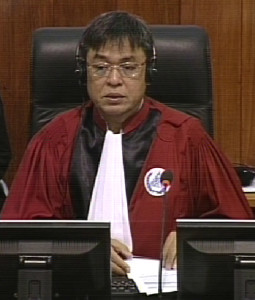
Trial Chamber President Nil Nonn
Trial Chamber President Nil Nonn announced that first the remainder of Civil Party Chum Mey would be heard, followed by submissions by the Nuon Chea Defense Team related to their request to admit further evidence, after which 2-TCW-919 would be heard. All parties were present, with Nuon Chea following the hearing from the holding cell.
Before the floor was granted to the Defense Team, Senior Assistant Prosecutor Vincent de Wilde stood up and referred to the list of four names that Nuon Chea Defense Counsel Victor Koppe had presented and said that they were arrested on the same day or approximately the same time as the Civil Party.[1] The Civil Party had not recognized the names of the persons. Mr. de Wilde pointed out that the people that Mr. Koppe had claimed were arrested at the same time as the Civil Party were actually months before the Civil Party, namely in April and May 1978.[2] The other persons that Mr. Mey had said were arrested with him were also found on the list (Rin, Net alias Tin and Kri alias Kim) and were arrested on 27 and 28 October 1978.[3] Moreover, Mr. Koppe pointed out that Kun and Yun g were also on the S-21 list.[4] Thus, the people had not been arrested on the same day or around the same time. Moreover, the names that the Civil Party had cited could also be found on the S-21 list, which also included Chum Mey.[5]
Mr. Koppe said that the information they had used yesterday were from the list of the Office of the Co-Investigating Judges, which stated that the days of the arrests were the same as for Chum Mey.[6] He said that this pointed towards a discussion that they needed to have at some point about the status of this list. He therefore rejected the allegation that they used false information to put pressure on the Civil Party. Moreover, he announced that they were preparing a request to summon the person who had drawn up this list. Mr. de Wilde said that he had seen the dates on the revised list by the Co-Prosecutors.[7]
International Civil Party Lead Co-Lawyer Marie Guiraud took the stance and, after being reminded that she should have stood up earlier, said that she had wanted to react to the remarks made by Mr. Koppe. She said that they had cross-checked the list and found discrepancies between the dates that the persons entered S-21 according to Mr. Koppe and when Chum Mey had entered the prison. The list had therefore been misread.
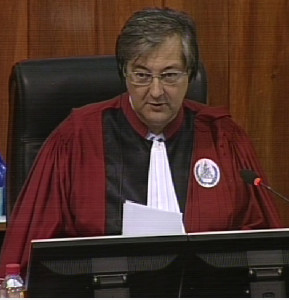
Judge Jean-Marc Lavergne
Mr. Koppe reiterated that he had found the dates on the list as he had cited them yesterday. Judge Jean-Marc Lavergne said that there was a problem if the Prosecution and Civil Party lawyers alleged that he had misused the information, while Mr. Koppe insisted that he had extracted the information from the OCIJ list.
The President concluded the discussion. He reminded the parties that they had to read the names and document numbers slowly and repeat if necessary. Moreover, objections had to be raised immediately. Lastly, he said that no parties should “not use the Chamber as a lecturing ground as in the university”. Parties had the right to question the witnesses and civil parties as they wished and other parties should not object on the basis of what strategy they used.
Civil Party Chum Mey raised his hand and said that the questions had not been clear yesterday. When he was arrested, only he, Ta Tin and Ta Khim were arrested.
Confessions
The floor was then handed over to the Nuon Chea Defense Team to continue their examination. Mr. Koppe referred to the Civil Party’s interview with the Co-Investigating Judges, in which the witness had talked about his confession.[8] He had said that it was partially true, such as the position that he had held, while it was invented that he belonged to CIA or KTB and conducting sabotage. Mr. Koppe inquired whether he remembered saying this to the Co-Investigating Judges. Mr. Mey confirmed this. He saw his confession for the first time during this interview. He had not read the whole 43-page confession, but skimmed through it. It was difficult to read for him due to his limited education and because of his poor eye sight.
Mr. Koppe asked whether it was correct that his involvement with Prince Chang Raingsey could not be found in his confession. Mr. Mey replied that he “did not implicate him during the time”.
Mr. Koppe said that in the approximately 11,000-word confession, CIA only appeared 11 times. The rest of the confession referred to events at the garment factory. When Mr. Koppe asked whether it was correct that the vast majority of the confession did not refer to the CIA but to the garment factory, International Civil Party Lead Co-Lawyer interjected and said that counsel was using the content of the confession and that this went too far. Mr. Koppe replied that the Prosecution was allowed to use names of confessions yesterday and that he had not “crossed the line yet”. The President said that it had only been an observation and that the Chamber would therefore not rule on it. Judge Claudia Fenz asked Ms. Guiraud whether she had objected or made an observation. Ms. Guiraud replied that she had made an observation, but that she was making an objection now to hear the ruling of the Chamber. The President allowed the question.
Mr. Koppe repeated the question. Mr. Mey replied that he was beaten up and asked whether he had joined the CIA and was asked who introduced him to the CIA.
Mr. Koppe asked about the person Kun. Mr. Mey recounted that he was the chief of the garment factory. Mr. Koppe asked whether he had heard of Doeun, who had been chief of Office 870 and was connected to Koy Thuon, which the Civil Party denied.
Clarifications
Turning to his next topic, Mr. Koppe read an excerpt of the re-enactment document of S-21, during which he had indicated where he was tortured, where he was detained, and where he worked.[9] He replied that he was not detained in Building A, but in Building C.[10] Mr. Koppe pointed to anther document, which also indicated that he was detained at the top floor at Building A. Duch had reacted to this and said that the place Chum Mey was tortured at was usually reserved for important and foreign persons. Duch had said that it might have taken place due to confusion. The Civil Party said that Duch’s statement was correct and that he was beaten up at Building A, after which he was detained at Building C.
After a brief discussion about the appropriateness of the questions, Mr. Koppe moved on and turned to the topic of S-24/Prey Sar. He asked whether his understanding was correct that he had said that he felt lucky having met his children and wife at Prey Sar, which the Civil Party confirmed. Mr. Koppe asked how it was possible to encounter his wife, since she was re-educated and detained there. Mr. Mey replied that he had not known that his wife was detained at Prey Sar. When the Vietnamese troops arrived, they were taken to Amleang. He met his wife and a group of women on the way to Amleang, who had given birth to a child two months before. They were separated during a fire exchange. He did not know whether there were other prisoners than the ten women he met. He only heard later that some women had been detained at Prey Sar.
In his previous testimony on 30 June 2009, Mr. Mey had talked about 2,000 children who were detained at Prey Sar.[11] Mr. Mey replied that Vann Nath had told him that around 2,000 children were killed and 20,000 men were killed. He said that there was “no clear figure from anyone” and that even Duch only estimated numbers.
Mr. Koppe requested leave to show a 10-minute footage of the East German documentary that they had mentioned yesterday after the break (Die Angkar). The request was granted.
Documentary: Die Angkar
After the break, the floor was handed to Judge Lavergne, who said that they had counterchecked the dates indicated on the S-21 prisoner list.[12] He said that the assertion that the prisoners 665, 9337, 9431, 10,651 entered at the same date or approximately the same time, was erroneous.
Mr. Koppe said he would look into this issue and give a response later. He then continued his examination and wanted to know why he had never mentioned the speech given by Nuon Chea before. The Civil Party replied that he was before the Chamber now and said that he wanted “to know whether [Nuon Chea] was aware of Tuol Sleng Prison in Phnom Penh city”. The President interrupted and instructed Mr. Koppe to repeat the question. The Civil Party said that yesterday jogged his memory when the Prosecution asked him whether he had ever seen Nuon Chea. He replied that it might have taken place in late 1976 or early 1977. Someone told him that the person who gave the speech was Nuon Chea. There were no other speakers at that time. He was transferred to the garment factory at Psar Orussey in 1976. He was not sure when the meeting took place. Neither could he recall well how many people participated, but he estimated that around 500 people participated in it.
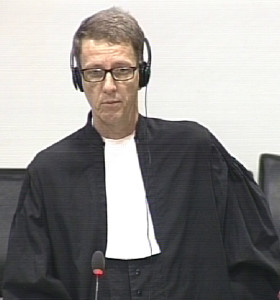
International Nuon Chea Defense Counsel Victor Koppe
When Mr. Koppe requested leave to show the movie, National Civil Party Lead Co-Lawyer Pich Ang intercepted and remarked that the Civil Party had poor eyesight. The President instructed the video to be shown and told the Civil Party to try to watch the video despite his poor eyesight. The excerpt of the Die Angkar documentary was around ten minutes long (starting at 10:29) and introduced seven survivors of S-21 in the beginning. Four of the seven people then talked about their experience, which circled around a lack of hope, fear, and torture. After showing the footage, Mr. Koppe inquired whether Mr. Mey remembered now being filmed in 1981. He replied that he had not seen the footage before. He could recalled that Ung Pech called him to join the group of people on the photo, after which he returned to work. Ung Pech was in charge of Tuol Sleng museum. Mr. Koppe wanted to know whether the issue of Ung Pech having only mentioned four survivors, not including Mey, came up in 1981. Mr. Mey recounted that Ung Pech had been arrested before he was arrested. Mr. Koppe then asked whether he knew how the other survivors got into possession of their S-21 photos. Mr. Mey replied that the photographer collected “basket-loads” of photographs, which were burned.
As a last question, telling the Civil Party not to be upset, he asked: “we have doubts as to you really being an -21 prisoner. So my question to you is: were you really an S-21 prisoner?” At this point, Mr. de Wilde interjected and said that there was no basis for this question and that it was humiliating. He had been on the S-21 prisoner list and they had his confession. Not being able to find his photograph and not being interviewed by East German film crew did not form a basis. Mr. Koppe replied that they had to ask this question and that the main reason of doubt was the fact that Ung Pech had not mentioned Chum Mey as one of the survivors. Ms. Guiraud said that Ung Pech did not say that there were only four survivors, but instead said
“Four survivors of the Tuol Sleng Prison are (1) Ung Pech; (2) Lep Chan, an engraver; (3) Nath, an artist (engraver); and (4) Rui Na Kong, a carpenter. We four presently work together in the First Brigade, Phnom Penh.”
That there were only four survivors was the defense counsel’s interpretation, Ms. Guiraud said.
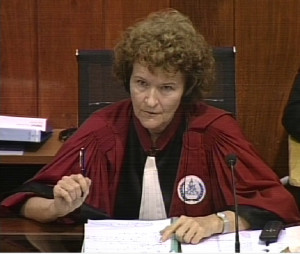
Judge Claudia Fenz
Judge Fenz said that she gave the last word to the Civil Party to close this chapter: “Sir, have you been in S-21?” Mr. Mey replied with a question: “how come such a question is put to me repeatedly? You can also refer to my confessions there where I was forced to put my thumbprint on”. Judge Fenz said that she did not doubt him, but gave him the last word instead. “Yes, I was there. […] And if I was not detained there, I swear that I would be killed by a car on my way leaving the court”.
The President then gave the opportunity for the Civil Party to give his impact statement on harm and suffering and put questions to the accused through the bench.
Impact statement
“The situation was so hard for me after I was arrested and detained at Tuol Sleng. They lied to me that I would be sent to repair vehicles in Vietnam, but in fact I was sent to a house to the east in Tuol Sleng. And I did not know that a group of them were hiding behind the house. Then they handcuffed me and the three of us were blindfolded. So they walked us across the road into Tuol Sleng. And I thought to myself that I may not live. And I told that to the other men. They kicked me and they pulled me and they scolded me that we would be smashed by Angkar. Then I was sent to a cell. I was ordered to stand straight and they measured my height and they photographed me. They took off my pants, they handcuffed my hands and blindfolded me. And then they sent me into a cell which was about 1.5 by 2 meters. Then I was shackled and after that they removed the cuff and the blindfold.
I was so thirsty at the time, but I did not dare to ask for water. And by 1 o’clock I was taken to the south building, that is building A, and I was interrogated on the upper floor.
Up there I was shackled again, then they took off the cuff and they took off the blindfold and I could see the surrounding areas in the room. I saw a pool of blood to the right and a bunch of clubs near a table where a typewriter was sitting there. They interrogated me how many of us actually joined the CIA or KTB and I told them that I had no clue about this CIA or KTB. And I responded to them by using the word comrade, and then they scolded me and they beat me and my little finger was broken. Then my toenail was pulled. And as they could not pull it out in one move, then they moved it very rapidly, and it was so painful. Then they used electrical wires to shock me in my ear and I became unconscious after that. And now one side of my face was damaged. I could hear the ringing in my ear […]. And I also had hard-hearing on my other ear. And I believed I could not survive because of this act. They kept on interrogating me and I still said I did not know anything about the CIA or the KTB. And they threatened me not to lie to Angkar, as Angkar never caught anyone [without] any mistake.
They kept interrogating me for 12 days and nights about KTB and CIA. And I was ordered not to say anything about Khmer Krom. During the 12 days and nights period, in the morning I was only given a spoon of watery gruel, and in the afternoon the same watery gruel was given to me in a spoon. I became so fatigue as the food was not sufficient. I was thinking to myself that I was given this watery gruel so that I could not gain the power to resist their interrogation. During the 12 day and night saga, I was interrogated and I saw a cartridge container in the room where I was ordered to relieve myself in. But because of the shackle on my ankles, the watery fishes could not all go into the container so it spilled out and then I was ordered to lick it dry. I was so afraid and my back was swollen during the 12 night saga.
I could not even move at night, because if I moved and then the chain made sound, then I would be beaten again. The situation was so miserable. I saw that myself being treated in less condition than a human being – less than a dog! A dog would be given food to eat, but for me I was given only watery gruel. And for what mistake I made? I did not make any mistake.
I tried my best to work for them day and night to repair sewing machines. But I was mistreated in such a terrible condition. And in the end one of them named Suf Thy came to ask who was brought in from Orussey and I said yes, and he said that tomorrow I would be allowed to work outside, but I was warned not to flee. Next morning, Suf Thy returned with some clothes for me to wear and he removed the shackles but put cuffs on my hands. I was asked to wear [pants] and a shirt, then they sent me to a back building to repair sewing machines. I repaired about ten sewing machines, and then their type writer was broken and a prisoner was asked to carry it to the back-building for me to repair it. I was asked whether I could repair it and I said allow me to see first, because while I was at Rattanakiri I used to type it. And then I saw a spring got loose, then I re-hooked it and it worked again. So they brought me two more typewriters to fix. And thanks to the springs that I re-hooked, I was spared.
And that was the time that the liberation troops along with the Vietnamese troops came to the east part of Psar Thmey – that is the Central Market – and 18 of us were gathered up to be housed at a place where Vann Nath worked. I was the last one to join the group and I saw them who pulled the triggers from the grenades and they were still holding in their hands and I was afraid that they would throw it into our room and that we would be killed.
And at noon time we were ordered to walk in a straight line while having a gun pointing at us, and we were allowed to wait outside the compound. And two of them came on a motorbike. And I did not know what they would be doing when they came. And only later on I learned that they actually came to slash the throats of the other 14 inmates in their bed. They did not dare to shoot them, as the sounds might be heard by us, but they slashed their throats. And when we were taken to Prey Sar, the female prisoners had been moved out and we stayed there for about 2 hours and we continued our journey, and then I met my wife at Ang Snuol. She was amongst the ten women there. And there were 18 of us from Tuol Sleng but there were those soldiers, but I didn’t know how many of them there were.
I asked permission to carry my young baby and my wife told me to take a scarf to a woman who had just delivered a baby under a palm tree. I delivered the scarf and while we were crossing to the north part of the road, we were separated by a gunfire exchange between them and the liberation front and the Vietnamese troops. So Nath was left behind and returned, while we headed to Amleang. I, Ta Eng and my wife continued our journey.
I did not dare to leave my wife behind, since she could not move fast from the fact that she had just delivered the baby. We reached an area called Sra Thuol, near Amleang, we were so starving and I asked for rice from the people in the area. And about five or six o’clock in the afternoon, I saw a group of Khmer Rouge, and there were about 50 or 60 of them.
And I saw one of them who was blind in one eye, named Comrade Sor. They asked me about my native village and that I was from the East Zone and they said that I should stay here then ask for rice from Angkar.so we stayed here in the school – or sala – and then this Khmer Rouge group left. However, there was a militiaman who came to look at our group. And at about 12, midnight, although this is just my guess, since I did not have a watch to look at, they asked about the 3 militia who were sleeping in a bed. I woke up and then I woke my wife and Eng up.
They said that they received a letter from Angkar and that my wife should walk first, since she could not walk fast. So my wife walked first, then Ta Eng and I was the last person. We were around one kilometer from the pagoda when we were fired at. Then my wife shouted at me to run away, because we were fired upon. Ta Eng was shot and he shouted to me to run as well. So I ran away for about 10 meters and then they actually turned the fire at me. I did not know whether they ran out of bullets, or whether because I was hiding myself behind a termite mount, and then I crawled along the rice field dyke to escape. Then I ran into the forest to hide myself.
And about seven or eight o’clock at night, I ran for three days and nights from Sra Thum Area. Then I met two women who were carrying rice on their heads. I asked where Thma Poun was. They were surprised and they said that Thma Poun was actually behind. So I had to run bag. During this six or seven day saga I had nothing to eat, nothing to drink, but I found some wild tree leaves and I ate it, I ate these bitter leaves. Then I found Thma Poun Mountain, and after that, I returned to Phnom Penh.
Questions to the accused
I like to put questions to the accused – that is Nuon Chea: That in his capacity as the senior leader of the regime, did he know about Tuol Sleng museum, did he know about the location of Tuol Sleng, and did he have any communication with Duch? That is my first question and here is my second question and again to Nuon Chea: did he participate in any mass meetings held at Borey Keylah? Did he say that anyone who is not clear from the imperialist, then these people should tell the party and they would be forgiven by the Party? I also have a question for Khieu Samphan: did he ever go to Orussey market? And if so, did he tell the women who cooked the rice that they should cook more rice for the people who arrived from the east zone? And did he distribute the rice to the people at the railway station – that is those people who have been evacuated from Prey Veng and Svay Rieng? These are my questions, Mr. President.
The President informed the Civil Party that the co-accused exercised their right to remain silent.
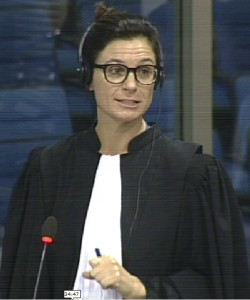
International Civil Party Lead Co-Lawyer Marie Guiraud
Before the President adjourned the hearing for a break, Ms. Guiraud said that they had a German-speaking jurist in the team. This person indicated that the documentary clearly said that there were seven survivors at Tuol Sleng when showing a photograph that also showed Chum Mey (at around 10:33). The President then thanked the Civil Party and dismissed him.
Submissions and responses
After the lunch break, the President announced that submissions would be heard with regards to two requests: one by the Nuon Chea Defense Team, and one by the Co-Prosecutors. This would be followed by the testimony of 2-TCW-919.
The Nuon Chea Defense Team had requested to admit a document for the questioning of 2-TCW-919. This was a book authored by the witness.
Mr. Koppe explained that they requested to admit eight documents in relation to 2-TCW-919. The first was a report by OCIJ investigator Bernard Brum in relation to his encounter with the witness. The second was a Phnom Penh Post of 16 August 2002: Who Owns Tuol Sleng Photos (Patrick Falby). The third was another Phnom Penh Post article (“Tuol Sleng Photographer Begins Building Khmer Rouge Museum” by Sam Rith). The fourth one was an article by the Center of Holocaust and Genocide of the University of Minnesota. The fifth was a Cambodia Daily article of 6 March 2015 entitled “S-21 Photographers Book Sells Banned at Museum” by Khuon Narim. The sixth document Mr. Koppe sought to be admitted were photographs of witness 2-TCW-919. The sevenths document was a photograph of the S-21 guards from the book The Lost Executioner by Nic Dunlop. The eighth one was a photograph of Chin Meth, which was at display at the Tuol Sleng museum and who claimed to have been detained at S-21 and subsequently sent to S-24.
Some documents were available prior to trial, so he admitted to have been tardy with regards to a few. However, he compared the situation to yesterday, in which the book by the Civil Party was admitted. Moreover, it was only known to them recently that this particular witness would come testify recently. As for the book, they did not have a copy, but the witness should have it and, if not, would be able to bring it tomorrow.
Judge Fenz asked Mr. Koppe whether he sought to admit a book that he had not read and wondered how he could determine the possible relevance of it. Mr. Koppe replied that it was highly likely that this was relevant, since it was entitled Nhem En’s Personal Memoir at S-21, and therefore probably dealt with his experience at S-21.
Senior Assistant Dale Lysak said that it was “a little odd” to ask for documents that were used to show that the witness was not credible, since the Nuon Chea had been the ones requesting the summonsing of this witness. He had no objection to the documents in particular, but questioned the relevance of the Cambodia Daily article. He further said that it had been established that the photograph of the eighth document was taken at Prey Sar/S-24. He did not object to the admission of the book, but would do so if this resulted in a delay or a recalling of the witness for questioning him on the book.
Civil Party Lead Co-Lawyers had only one remark with regards to the book. To Ms. Guiraud, it seemed to be premature, since no one had seen this book. She argued that the situation was different to situation yesterday, since no one had seen the book. There was no objection from the Khieu Samphan Defense Team.
Mr. Koppe said that they were fully dependent on the information that was available on the Case File and could not conduct their own investigations. He had given another statement to the investigators after they had requested to call him, which made them doubt the witness’s credibility. They could also not ask the witness for the book himself.
Judge Fenz said that he could have asked the Chamber to provide him with the book earlier. Mr. Koppe said that the Chamber could have asked the witness to bring the book with him.
Kong Sam Onn – conflict of interest
The President said that Khieu Samphan Defense Counsel had been a duty counsel in the previous case, which had resulted in a request by the Co-Prosecutors.[13] Mr. Lysak clarified that they did not seek the removal of Mr. Sam Onn due to possible conflict of interests. He suggested that a waiver should be received by the witnesses and Khieu Samphan. However, it would be better for Mr. Sam Onn not to question those witnesses that he had represented. Mr. Ang said that the Civil Party Lead Co-Lawyers did not have any observation with regards to this issue. Mr. Koppe reminded the Co-Prosecutors of the advice of the Defense Support Section to appoint Ieng Tirith’s defense counsel as a standby counsel. He said that the Co-Prosecutors had not filed anything. The Khieu Samphan Defense Team was able, he said, to decide themselves whether a conflict of interests existed. He pointed to a situation, where a counsel had represented two civil parties who had talked about the murder of a person. Mr. Koppe said that this showed a double standard of the Prosecution.
Mr. Sam Onn said that it was a “grave mistake” by the Co-Prosecutors to say that a conflict of interest might exist. He had consulted witnesses and not accused during Case 001. Moreover, he argued that there were no facts that alleged that Khieu Samphan was a leader or responsible. Hence, Mr. Sam Onn argued, no conflict of interest existed. The issue was not in the responsibility of the Co-Prosecutors. Furthermore, as for the request to produce a written waiver, he said that this was not necessary, “since Khieu Samphan has been aware of my duty counsel to the four trial witnesses before I became part of his case”. Additionally, he said that the allegations were against the current facts. “Khieu Samphan […] had no relationship directly or indirectly with any of the four upcoming witnesses”. Thus, “it is impossible that conflict of interest may arise”. It was also his duty to adhere to the rule of confidentiality. He agreed to the solution by the Trial Chamber that he may not question the four witnesses.
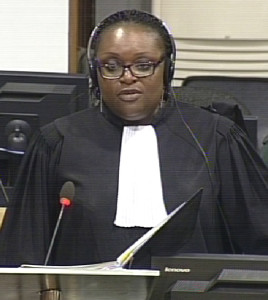
International Khieu Samphan Defense Counsel Anta Guissé
Judge Fenz asked whether he would agree not to question the witness, which he did. She then asked whether it was possible for Khieu Samphan to sign a waiver for this conflict of interest. International Defense Counsel Anta Guissé said that the situation was clear and that no such waiver was needed. Judge Fenz asked why her client was not willing to a waiver. Ms. Guissé said that they needed a 5-minute adjournment to discuss this matter with their client. Mr. Sam Onn reiterated that it was not necessary to have this waiver set up for Khieu Samphan.
As a reaction to an earlier statement by Mr. Koppe, Ms. Guiraud said that it was “ridiculous” to compare the situation with the one with Lyma Nguyen’s situation. Also as a reaction to Mr. Koppe’s statement about the stand-by counsel, Mr. Lysak said that the standby counsel for the Supreme Court hearings had never to represent the hearings and that the situation was not comparable. Moreover, they had never objected to the appointment of this standby-counsel and now seemed to make an issue out of it. Mr. Koppe disagreed and pointed to paragraph 14 of F2/10, in which they had pointed to the issue already. Judge Lavergne asked whether there was any intention by Khieu Samphan to react. Ms. Guissé said that she was used to speaking on behalf of her client and that she thought it was not necessary for him to speak.
The President announced that an oral ruling would be issued after the break.
New witness: S-21 photographer Nhem En
The witness was then ushered in. Mr. Nhem En was born on 9 September 1961 in Kampong Leang District, Kampong Cham Province. He has two houses: one in Siem Reap city. He has just resigned from his position as a district chief in Oddar Meanchey. He has a business now and cooperates with a Korean business partner to produce books about his experience at Tuol Sleng. He did not have the book with him today. He got “married in the jungle” in 1980 and had six children. He separated from his wife in 1985 and married another woman, with whom he has one child.
The floor was first given to Judge Fenz to put questions. She inquired about the book he had published and wanted to know the title. He said that it was called Nhem En- the photographer of Tuol Sleng in Democratic Kampuchea. He was the author and was assisted by Dara Duong, who was an advisor to Hun Sen. He said he would bring 50 copies tomorrow. At the moment, it was only available in English, but he planned to translate it into 17 languages. It was published on 1 January 2015. He said that it was based on his own experience and his work as a photographer at Tuol Sleng. At this point, the President adjourned the hearing for a break.
Clarifications
After the break, the President issued the oral decision on the request by Nuon Chea. The Chamber decided to admit seven of the eight documents. The article by the Cambodia Daily was rejected. A separate ruling for the book would follow. The decision on Khieu Samphan Defense Counsel Kong Sam Onn’s possible conflict of interest was deferred.
Mr. Koppe then took up the questioning. He asked about the date of birth, since he had said that he was born in 1959 and in another Written Record of Interview that he was born in 1961. Mr. En said that he “was pretty sure that I was born in 1961”, but his wife put the date 1959. Mr. Koppe wanted to show one of the photographs that had just been admitted by the Chamber to the witness. The request was granted.[14] He said that the photograph showed himself and was taken by himself. The age on the photo was 16 years old. The witness reiterated that he was born in 1961 and said that his father was a school principal and had noted it down.
He confirmed that he went to China for a training in photography. In May 1975, he returned from Kampong Chhang to Phnom Penh. By early 1976, he was selected by Angkar to go to China. At that time, Son Sen was the foreign minister. He went there in January 1976 and returned in June of the same year. They stayed in part of Shanghai. He was sent to study six subjects: 1) filming 2) developing photography 3) drawing. He did no mention the rest of the subjects. “Although there is no evidence”, he said, he had notes of the techniques he learned while being in China. Mr. Koppe said that he had said in his Written Record of Interview that he had photos of his trip to China and the visit of Ta Nath.[15] Mr. En replied that he had photos of Nath in China but in Vietnam. Mr. Koppe said that Duch had testified that En never went to China, but that Pol Pot’s cousin went there instead.[16] The witness replied that Duch only started to know him in mid-1976 and did not know him before.
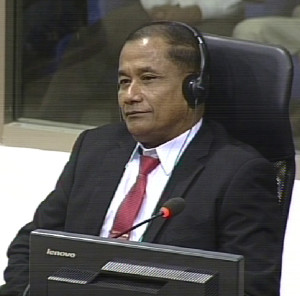
Witness Nhem En
Mr. Koppe wanted to know whether he remembered taking photos of leaders at Trapeang Thma. The witness replied that he remembered going to Trapeang Thma, Trapeang Puoy and 1st of January Dam and took photos there. He said that he had photos of Ruos Nhim and the Northeast Zone. He said that he could send them to the Chamber, but that he left a few of them at home. Besides his core responsibility to take photos, he had to also grow vegetables and other tasks. Mr. Koppe said that En had set out a few tasks he had done earlier, such as having a small shop and taking photos at the general staff and delivered letters.[17] He said that this was true and that this took place before he went to China. Mr. Koppe asked whether this was not “a lot of responsibility” for a 16-year old adolescent. He replied that he had no choice but to do the assigned tasks. At least 2,000 children studied techniques under a division.
Division 703 and prison staff
After the war ended, Angkar trained them to prepare for a possible future war. Mr. Koppe wanted to know whether this was the reason why he said that Nath and Phim were Division 703 chiefs.
Mr. Koppe inquired whether he had ever heard the name Sen or Brother 03. The witness replied that he could not remember well. Duch had testified in 2009 about photographers.[18] The witness said that this was correct and said that 50% of the staff members of S-21 came from Division 703 and children from Sector 31. He knew many of the interrogators “and the murderers”, many of whom came from Division 703.
Ta Hor was the former member of the regiment Division 12. Sothea, Prak Horn and Ta Houy were all members. Sothea held the list of prisoners. Ta Yut used to be a prison chief on a mountain.
Mr. Koppe asked whether he had ever heard that Duch was involved in the liberation of Phnom Penh and fighting in 1975 with Division 12.
Mr. Koppe referred to a DC-Cam booklet on Division 703.[19] The author talked about a person called Meng Hak. Mr. Koppe wanted to know whether Division 703 was in control of the rice farm at Prey Sar and Choeung Ek. The witness replied that there were many divisions in Phnom Penh, but that Choeung Ek was under the control of Division 703. According to the witness, this division was a special division and had particular power. The security matters at Olympic Stadium were under the responsibility of Division 703 and Division 502. Mr. Koppe then asked what the relation was between Division 703 and Sector 21. Mr. En said that Division 703 was in charge of Sector 21. When Mr. Koppe asked whether he said that Division 703 was higher in hierarchy than 21, the witness confirmed this.
He said that he started his work at Tuol Sleng in June 1976 and that there were six photographers: he, Ru, Ry, Som and Srean. He then said that he started his work in July 1976. He insisted that it was in June or July 1976, even if he had said that he started working there in 1977 at another point. The witness himself was in charge of Ry and Som. They had divided the photographers into two squads.
The President adjourned the hearing. It will continue tomorrow, April 20 2016, at 9 am with the testimony of Nhem En, followed by testimony of 2-TCW-865 and reserve witness 2-TCW-898.
[1] E3/93.2.
[2] E3/42 and E3/1668.
[3] E3/42, p. 42 (EN) and 43 (KH). Numbers 983, 10471, 2850.
[4] E3/42, 4869 and 2041.
[5] E3/2186.
[6] E393.2.
[7] E393.2 and E3/42, at number 665.
[8] E3/5163, at 00176401 (KH), 00176405 (EN), 00176408 (FR).
[9] E3/5769, at 00166590 (KH), 00166563 (EN), 00166573 (FR).
[10] E3/5765.
[11] E3/7451, at 11:04.
[12] E392.2.
[13] E397.
[14] D108/3/51.1, at00162875 (EN).
[15] E3/68, at 00401819 (EN), 00162837 (KH), 00195658 (FR).
[16] E3/7468, 4 August, 16:11.
[17] E3/68.
[18] E3/5794, at 27 April 2009, 10:07.
[19] E3/2117, at 00081318 (EN), 00192958-59 (KH).
Featured Image: Civil Party Chum Mey (ECCC: Flickr).

[…] He said there were six photographers split in two groups, and he was in charge of two other photographers. He testified that he took photos of Ruos Nhim and the Northeast Zone as well as other duties such as having a shop, taking staff photos and delivering letters. In response to a question about the level of responsibility given to a 16 year old Mr. En stated “[w]e had no choice but to do what was assigned to us”. En also stated that “I knew many of the interrogators and the murderers…Many of them, later on, were also killed.” Defense lawyer for Nuon Chea, Mr. Victor Koppe questioned the witnesses’ credibility. The defense also sought to admit a book written by Mr. En, which the court allowed. (Phnom Penh Post, Cambodia Tribunal Monitor) […]
[…] Defence also sought to admit a book written by Mr. En, which the court allowed. (Phnom Penh Post, Phnom Penh Post, Cambodia Tribunal Monitor) Mladic Defence witness questions veracity of Tomasica evidence […]